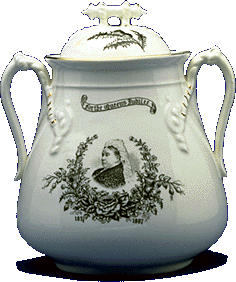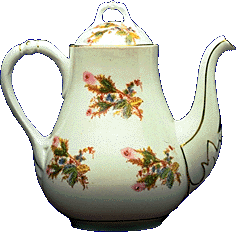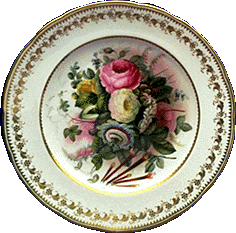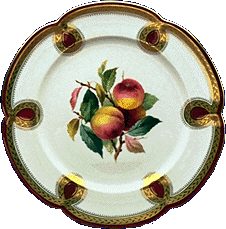 |
Shell Dish, Tureen and Stand, circa 1870 Maker: Unmarked France From the Manoir de la Sapinière Saint-Ours, Quebec Canadian Museum of Civilization Cat. no. A-2628 Slide no. 17940 |
|
|
|
||
PORCELAIN (part 2)Have "a snow-white cloth" and "beautiful china." These are "essentials." A book of etiquette published in Canada in the 1880s offered this advice to the bride on how to set her table. By the second half of the nineteenth century increasingly ample supplies of porcelain, and lower prices for at least some of it, put porcelain within reach of more people than ever before.Supplies continued to come from British potters but now there were also significant importations from Europe. French porcelain, much of it moderately priced, came rapidly to the fore in the Canadian market.
Belleek, the new Irish porcelain, was extensively promoted from the beginning of the 1870s. When Queen Victoria's jubilees were celebrated, in 1887 and 1897, a flood of porcelain teaware commemorating the events came from potters all over the British Isles. Some Canadian importers had their own names added to these wares. Towards the end of the century, the craze for amateur china decorating prompted both china merchants and dealers in art supplies to bring in large stocks of English and French wares "in the white." Porcelain, rather than earthenware, was the preferred "canvas" for many of the young ladies who took up china painting.
With new settlements opening up in the West and Canada's population growing, the demand for ceramic wares of all types was constantly increasing. Porcelain was playing a more important role in this market than had been known in the past.
Before mid-nineteenth century there were occasional advertisements for French porcelain. In the 1820s and the 1830s it was possible to purchase Paris porcelain in Montreal, for example, and in Saint John, New Brunswick. But these were isolated instances. It was from about the 1840s on that the taste for French porcelain really took hold. Some bought it on trips to France. A young couple from the Eastern Townships of Quebec made a wedding trip to Paris in 1860 and ordered dinner, dessert, tea and coffee ware while there. They had it painted with their initial, "F" (for Farwell). A sugar bowl from their china is in the Museum's collection.
The most popular of all was French porcelain from Limoges painted with moss rose decoration. A tea set of this type became the goal of farm and city wife alike, and could be priced within the reach of both.
As early as the 1860s some importers of ceramic wares were setting up their own decorating studios. They would order undecorated tablewares from their overseas suppliers and then add decoration in Canada, according to customers' requirements. This practice gave new employment opportunities. Professional china painters opened their own studios. Amateurs, particularly ladies, took up china painting. The result was that classes were offered in the art in all parts of the country.
One of the best-known teachers was John Griffiths. With his brother James, he had emigrated to London, Ontario in the 1850s. Both brothers had been trained as china painters at home in Staffordshire. James took up other employment in Canada but did not abandon art. He became a charter member of the Royal Canadian Academy when it was founded in 1880. John acquired a farm outside what were then the boundaries of London, but paid scant attention to it. His various activities included teaching china painting and experimenting with the use of photography as a means of decorating porcelain. In the Museum's extensive collection of Griffiths materials is a small porcelain mug with a photographic representation of Eliza, the eldest of John's daughters. |
||||||||||||||||||||||||||||||||||||||||||||||||







